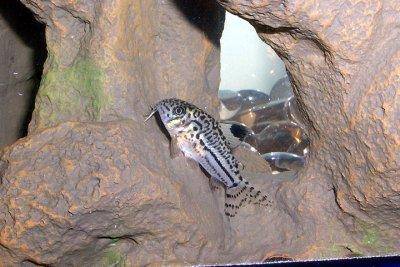Julii cory - Corydoras julii
Scientific name: Corydoras julii
Common name: Julii cory
Family: Callichthyidae
Usual size in fish tanks: 3 - 4 cm (1.18 - 1.57 inch)
014
Recommended pH range for the species: 6.5 - 7.8
Recommended water hardness (dGH): 4 - 18°N (71.43 - 321.43ppm)
0°C 32°F30°C 86°F
Recommended temperature: 25 - 28 °C (77 - 82.4°F)
The way how these fish reproduce: Spawning
Where the species comes from: South America
Temperament to its own species: peaceful
Temperament toward other fish species: peaceful
Usual place in the tank: Bottom levels
Feeding
Corydoras julii are omnivores and easily adapt to a variety of foods. They eagerly accept sinking pellets, algae wafers, granules, and leftover flakes. To ensure optimal health, provide a varied diet that includes brine shrimp, bloodworms, and other small live or frozen foods. Feeding in the evening or after lights go out is ideal, as they are more active at the bottom during quiet times.
Origin
Corydoras julii, commonly known as Julii cory, originates from slow-moving tributaries, backwaters, and floodplain rivers in South America, especially in the central and lower Amazon Basin. They are primarily found in Brazil, where seasonal flooding creates complex aquatic environments teeming with life. These habitats often have soft, sandy or muddy substrates covered in a layer of decomposing leaf litter, branches, and aquatic plants.
Julii corys are bottom-dwellers and spend much of their time sifting through the substrate with their sensitive barbels in search of small invertebrates, detritus, and biofilm. The water in their native environment is typically warm, slightly acidic to neutral, and well-oxygenated, often shaded by overhanging vegetation. They are well adapted to environments with fluctuating water levels, and during the rainy season, they migrate into newly flooded forest areas where food is plentiful and competition is low.
Ecologically, Julii corys play an important role in nutrient cycling by helping to break down organic matter. Their constant foraging helps aerate the substrate and control populations of small invertebrates, contributing to the balance of the ecosystem. Their peaceful nature and fascinating behavior make them not only an ecological asset in the wild but also a popular and beneficial addition to community aquariums.
Sexing
Sexing Julii corys can be tricky. Females are generally rounder and slightly larger than males, especially noticeable when viewed from above during breeding periods.
Breeding
Corydoras julii are egg scatterers. To encourage spawning, keep them in groups of at least 5–6 in soft, clean water and simulate rainy season conditions by performing frequent cool water changes. The female lays adhesive eggs on plant leaves, glass, or decorations. Eggs hatch in 2–3 days. Remove adults after spawning to prevent them from eating the eggs. Fry can be fed infusoria or newly hatched brine shrimp until they grow large enough for crushed flakes and micro-pellets.
Lifespan
With proper care, Julii corys can live for 5–7 years in a well-maintained aquarium.
Short Description
Corydoras julii are peaceful and social bottom-dwelling catfish known for their elegant spotted pattern and active behavior. They are ideal for community tanks and should always be kept in groups of at least 5 to reduce stress and encourage natural behavior. A soft sand substrate is essential to protect their sensitive barbels.
Provide plenty of shaded areas using driftwood, rocks, and plants such as Java fern, Cryptocoryne, and floating species like frogbit. Ideal tankmates include neon tetras, ember tetras, Otocinclus, and other non-aggressive species. Avoid sharp gravel and strong currents, as these can damage their barbels and cause stress.
Pictures
Thanks to FLBettaCouple.







 Aspidoras
Aspidoras  Giant
Giant  Hognosed
Hognosed  Emerald
Emerald  Cascarudo
Cascarudo  Acre
Acre  Adolfo’s
Adolfo’s  Bronze
Bronze  Agassizii’s
Agassizii’s  Spotted
Spotted  Skunk
Skunk  Corydoras
Corydoras  Fairy
Fairy  Corydoras
Corydoras  Pink
Pink  San
San  Bond’s
Bond’s  Spotted
Spotted  Tailspot
Tailspot  Concolor
Concolor  Cope’s
Cope’s  Sand’s
Sand’s  False
False  False
False  Ehrhardt’s
Ehrhardt’s  Elegant
Elegant  Saddle
Saddle  Fowler’s
Fowler’s  Gomezi
Gomezi  Palespotted
Palespotted  Guapore
Guapore  Dainty
Dainty  Mosaic
Mosaic  Imitator
Imitator  Leopard
Leopard  Black
Black  Slant-bar
Slant-bar  Bluespotted
Bluespotted  False
False  Bandit
Bandit  Mini
Mini  Napo
Napo  Corydoras
Corydoras  Blue
Blue  Nijssen’s
Nijssen’s  Ornate
Ornate  Peppered
Peppered  Panda
Panda  Albertini
Albertini  Pastaza
Pastaza  Corydoras
Corydoras  Many-spotted
Many-spotted  Pretty
Pretty  Dwarf
Dwarf  Iridescent
Iridescent  Reticulated
Reticulated  Bannertail
Bannertail  Robust
Robust  Schwartz’s
Schwartz’s  Black
Black  Longnosed
Longnosed  Seuss’
Seuss’  Smudge
Smudge  Masquerade
Masquerade  False
False  Millenium
Millenium  Pinkthroat
Pinkthroat  Sterba’s
Sterba’s  Longsnout
Longsnout  False
False  Miguelito
Miguelito  Twosaddle
Twosaddle  Xingu
Xingu  Black
Black  Porthole
Porthole  Flagtail
Flagtail  Brown
Brown  Spotted
Spotted